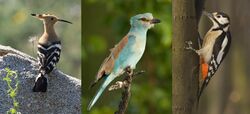Biology:Picocoraciae
From HandWiki
Short description: Clade of birds
| Picocoraciae | |
|---|---|

| |
| From left to right: Hoopoe (Upupa epops), European roller (Coracias garrulus) and Great spotted woodpecker (Dendrocopos major) | |
| Scientific classification | |
| Domain: | Eukaryota |
| Kingdom: | Animalia |
| Phylum: | Chordata |
| Class: | Aves |
| Clade: | Eucavitaves |
| Clade: | Picocoraciae Mayr, 2010 |
| Clades | |
Picocoraciae is a clade that contains the order Bucerotiformes (hornbills and hoopoes) and the clade Picodynastornithes (containing birds like kingfishers and rollers, and woodpeckers and toucans) supported by various genetic analysis[1][2][3][4][5][6] and morphological studies.[7] While these studies supported a sister grouping of Coraciiformes and Piciformes, a large scale, sparse supermatrix has suggested alternative sister relationship between Bucerotiformes and Piciformes instead.[8]
| Picocoraciae |
| ||||||||||||
References
- ↑ Hackett, S.J. (2008). "A Phylogenomic Study of Birds Reveals Their Evolutionary History". Science 320 (5884): 1763–8. doi:10.1126/science.1157704. PMID 18583609. Bibcode: 2008Sci...320.1763H.
- ↑ Ericson, P.G. (2012). "Evolution of terrestrial birds in three continents: biogeography and parallel radiations". Journal of Biogeography 39 (5): 813–824. doi:10.1111/j.1365-2699.2011.02650.x. Bibcode: 2012JBiog..39..813E. http://www.nrm.se/download/18.9ff3752132fdaeccb6800037316/1367705204607/Ericson+Gondwana+JBI+2012.pdf.
- ↑ Naish, D. (2012). "Birds." Pp. 379-423 in Brett-Surman, M.K., Holtz, T.R., and Farlow, J. O. (eds.), The Complete Dinosaur (Second Edition). Indiana University Press (Bloomington & Indianapolis).
- ↑ Yuri, T (2013). "Parsimony and model-based analyses of indels in avian nuclear genes reveal congruent and incongruent phylogenetic signals". Biology 2 (1): 419–44. doi:10.3390/biology2010419. PMID 24832669.
- ↑ Kimball, R.T. et al. (2013) Identifying localized biases in large datasets: A case study using the Avian Tree of Life. Mol Phylogenet Evol. doi:10.1016/j.ympev.2013.05.029
- ↑ Jarvis, E. D. et al. (2014). "Whole-genome analyses resolve early branches in the tree of life of modern birds". Science 346 (6215): 1320–1331. doi:10.1126/science.1253451. PMID 25504713. Bibcode: 2014Sci...346.1320J.
- ↑ Livezey, Bradley C.; Zusi, Richard L. (2007). "Higher-order phylogeny of modern birds (Theropoda, Aves: Neornithes) based on comparative anatomy. II. Analysis and discussion". Zoological Journal of the Linnean Society 149 (1): 1–95. doi:10.1111/j.1096-3642.2006.00293.x. PMID 18784798.
- ↑ Davis KE, Page RDM. Reweaving the Tapestry: a Supertree of Birds. PLOS Currents Tree of Life. 2014 Jun 9. Edition 1. doi:10.1371/currents.tol.c1af68dda7c999ed9f1e4b2d2df7a08e
Wikidata ☰ Q19598622 entry
 |

